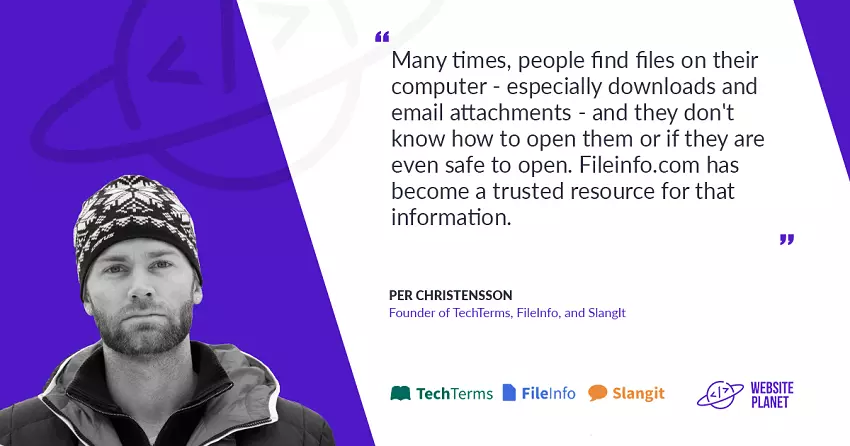In the brave new Digital World, terminology, files, and even personal communication can sometimes be confusing. That’s why, over ten years ago, Per Christensson started a personal project clarifying these terms for the rest of us. We talked with him about TechTerms, FileInfo, and SlangIt, how he manages to keep current with the seemingly endless addition of new terminology and how they have grown into trusted resources for defining technical terms, software files and contemporary slang.
Before we talk about your three sites individually, these are huge projects that seem like labors of love. Do you have a day job?
These sites did start as a hobby back in 1999 as pages on my initial website. But since then, there has been so much traffic that I’ve had to hire several people to help me manage them, so it has definitely become a full-time job!
What is techterms.com?
Back in the late 90s, before social media, a lot of people were making personal home pages. Rather than make a page about myself, I thought it would be cool to create a site with helpful information. I didn’t want to start something like a news site that would need updating every day, so I decided to create a glossary of computer terms because it is “evergreen” content.
I do my best to publish information that isn’t going to be outdated in a few months. Therefore, I have to be smart with the definitions I write so that they’re not time-specific, but also contain as much useful information as possible. I go through the site every week, adding and updating definitions, so it’s an ongoing process.

How do you stay on top of new terminology and what are some of the newer terms that you’ve added?
User suggestions are the main way I stay on top of new terms. I receive several requests per day, so every week I select the best ones and add those.
A recently submitted term that I was surprised I didn’t know is ASO or App Store Optimization. Like SEO (Search Engine Optimization), it is the process of achieving a high rank in search results. But instead of websites, it is for apps within app stores.
For example, Apple announced earlier this week that they have about 30,000 different photo apps. If you’ve developed an app for taking photos or adding filters, good luck in getting found. With strategic ASO, your app can appear in the top search results, and you can do very well.
Has any terminology changed since you started?
One example that comes to mind is Wi-Fi. The terminology is challenging because every few years, there is a new Wi-Fi standard. Many types of standards and protocols used on the internet can be equally difficult to keep up with because they are always changing.
I haven’t even added a definition for 5G in terms of cellular technology because the specification is not yet completely defined. I thought of adding a general definition, but every time I’ve researched it and am ready to publish it, the standards have changed.
Less technical terms also evolve. For instance, what a tablet can do today is different than what a tablet could do ten years ago.
What is a Tech Factor Rating?
The Tech Factor is an indicator of how technical or advanced a term is for the typical user. So, a word like computer is rated at a 1 out of 10 while a word like thyristor, which is a very small internal component within a processor, is a 10.
While the Tech Factor Rating is subjective, it has been helpful to TechTerms visitors. When a new user wants to browse through the terms, I recommend starting with terms rated 1 – 3, then 4 – 7 and then 8, 9, and 10 as their technical knowledge progresses.
What is fileinfo.com?
FileInfo.com grew from a single page that listed common file types like .DOC, .PDF, and .JPEG and some that were less well-known like .ZIP and .PHP. As the list grew to a few hundred file types, I realized that like techterms.com, it needed to become its own website. We currently have over 11,000 file extensions in our database, which continues growing almost every day.
Many times, people find files on their computer – especially downloads and email attachments – and they don’t know how to open them or if they are even safe to open. Fileinfo.com has become a trusted resource for that information. In fact, of our three sites, it receives the most traffic.
How do you keep apprised of new file types and do they need to attain a certain level of popularity to be added?
Like techterms.com, most of our new file types come from website visitors. A good percentage come directly from developers. Developer suggestions are my favorites because it shows that the programming community takes fileinfo.com seriously as the largest and most well-recognized file types resource on the web. Since there is no central file extension registry, developers also like to “reserve” their file extensions through fileinfo.com, helping avoid future problems with file extension conflicts.
We do add file types that are more obscure as well. Just this week we’ve added a few file extensions for old Casio and Texas Instruments graphing calculators. The number of people who use these file types is very small, but for those people, they’re important.

Do file types from obsolete software remain in the database?
Yes. A good example is a word processing document (.WPS file) created by Microsoft Works, a slimmed-down version of Microsoft Office. Although the software was discontinued and has not been maintained for almost ten years, it is still a commonly seen file type because back in the day, so many users created .WPS files. So it’s important to keep that file type information on the website. We also list current software for Mac, Windows, and Linux that can open or convert .WPS files. We do the same for files created by other obsolete programs.
Tell me about slangit.com
Just like the other two websites, slangit.com started as a single page on my old website. The initial database was built to define slang terms, chat acronyms, emoticons, and eventually emojis that I had seen on the web. Over the last couple of years, it has grown as a combination of user suggestions and new terms or acronyms that my team comes across.
A great example was the recent Apple announcement of the new iPhone 11. While I was watching the presentation, a woman talked about how the selfie camera can now take slow-motion videos or “slofies.” I immediately texted one of my employees, and he was already adding the new term “slofie” to SlangIt.
How do you determine which terms belong on the Parents’ Checklist?
Kids have come up with code words they don’t want their parents to understand. So, we went through our slang terms one by one and selected the terms we felt parents should know.
The checklist includes slang relating to parents, such as C9 (Parent in Room), PLOS (Parents Looking Over Shoulder), and AYPWOL (Are Your Parents Watching Or Listening), as well as those about concerning behavior like sex, drinking, smoking, and drugs.
Slang and acronyms are made-up terms. How do you determine if a submission belongs in your database?
We don’t want to propagate unnecessary slang to the point where it becomes ridiculous, so we use discretion. Generally, if we’ve never seen a term used before and can’t find any other references to people using it, we’ll file it into our “maybe” pile should it become widely used in the future.
What do you think it takes for an acronym or slang term to become popular?
It’s fascinating since there is no technically sound answer. Remember when an argument over the color of a dress blew up the Internet a few years ago? It was the dumbest thing, but it caught fire! An acronym or slang term might start when someone uses it because they don’t want to type extra characters or think it’s a funny term. Then somebody else posts in on social media, and then somebody else reposts it. Then it takes off and makes its way around the world.
Creating new slang is kind of like starting a fire with a little spark. Sometimes the spark fizzles out, but other times it catches fire and grows. Before you know it – you have a huge blaze.














